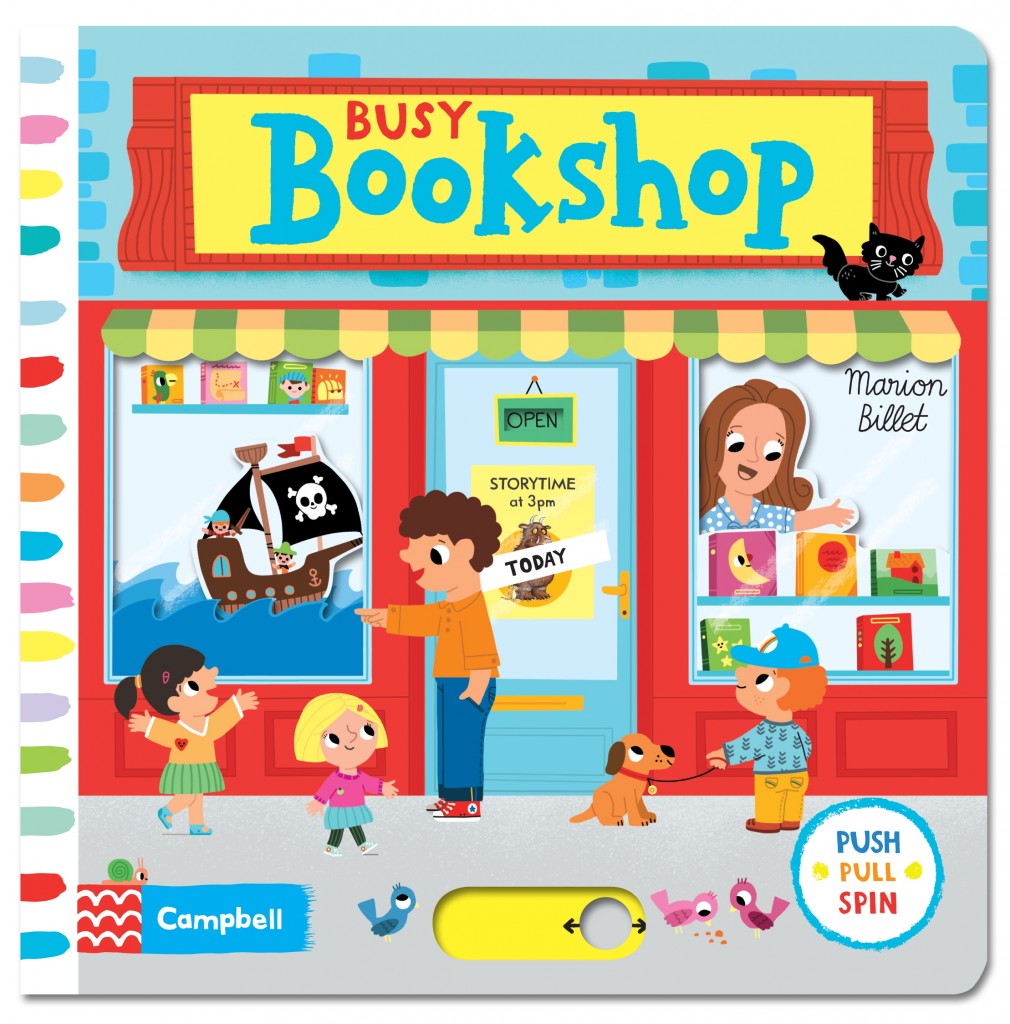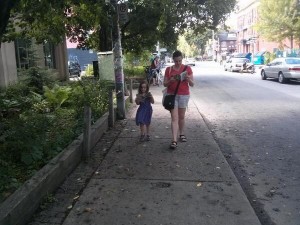October 3, 2014
30 Years with Anne Shirley
 The last time I read Anne of Green Gables was in 2008, when I came away struck by how much it’s actually Marilla’s story, her own transformation, the softening of her heart. All the things she feels about her adopted daughter but will not say, but she feels them—the narrative articulates the complexity of her emotions. Reading it again now, I laugh at the paragraph from Rachel Lynde’s perspective about Marilla’s definite ideas about how to bring up children, and how only people who’ve never had children can ever have these. I also notice how silly Anne is; with all her big words she gets so many wrong (though whether these are actually typos is hard to tell. My edition is appallingly edited)—she’s a more realistic version of a 12 year old precocious child than I’ve ever noticed before.
The last time I read Anne of Green Gables was in 2008, when I came away struck by how much it’s actually Marilla’s story, her own transformation, the softening of her heart. All the things she feels about her adopted daughter but will not say, but she feels them—the narrative articulates the complexity of her emotions. Reading it again now, I laugh at the paragraph from Rachel Lynde’s perspective about Marilla’s definite ideas about how to bring up children, and how only people who’ve never had children can ever have these. I also notice how silly Anne is; with all her big words she gets so many wrong (though whether these are actually typos is hard to tell. My edition is appallingly edited)—she’s a more realistic version of a 12 year old precocious child than I’ve ever noticed before.
This time, I am rereading Anne of Green Gables (the book I’ve been reading and rereading for 30 years now) as I never have before—aloud. It’s our current chapter book for bed time, joining a canon that includes the Little House books, Ramona, The Willoughbys, Tales of a Fourth Grade Nothing, Through the Looking Glass, and so many more. When we started reading it, I was surprised to discover I wasn’t sure it would work—there is so much description, so many words, in particular huge ones that no five year old has ever heard of. As we read through the first couple of chapters, it dawned on me that I’d come to the book at age 6 or so (first reading an abridged version) after being familiar with the Kevin Sullivan film—all the characters in my mind are precisely as cast therein. Would the story “take” the same without the cinematic precedence, I wondered? But it was the evening that we opened the book and Harriet had remembered the exact title of the chapter we’d left off at that I knew the story was resonating just as I’d hoped it would.
Reading Anne of Green Gables aloud is such a pleasure. So many words, as I said, but I get to say them. I’ve never had such a feel for the strength of Montgomery’s prose, and how effectively she communicates Anne’s incessant chatter. Reading aloud too, I get to convey the humour, of which there is so much, and it thrills me when the best jokes are met by Stuart’s laughter. Because he’s listening too, this being his first time “reading” Anne of Green Gables, as well as Harriet’s. He grew up in England, where Anne would be even more foreign to boyhood than usual. So I love that he’s enjoying this very Canadian experience, and Harriet too. (Iris spends story time entering and leaving the room, scattering chaos in her wake.) There are so many wonderful parts of the book that I’ve forgotten about, and when I glimpse an episode to come, I tell them, “Oh, this is going to be a good one.” When Anne turned her hair green, and jumping on Aunt Josephine’s bed, getting Diana drunk and saving Minnie May Berry, the mouse in the pudding and the lineament cake. The puffed sleeves. She’s just about to reconcile with Gilbert, and I absolutely cannot wait. We are enjoying this book so very much.
There is something to this book, which is far more than childhood nostalgia or attraction to a cultural touchstone. Anne of Green Gables is so familiar to us all that it gets written off more often than not, but that’s such a mistake. It’s a good-enough kids’ book, but there is so much going on in the text that a reader doesn’t notice when she’s young, and even when she’s not young. It’s a book that’s worth a reread every decade or so, at least.
September 27, 2014
Best Book of the Library Haul: I Like Old Clothes
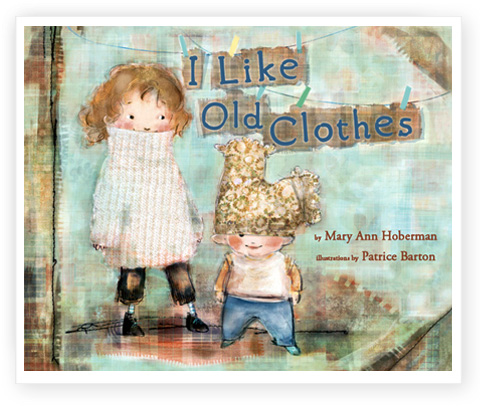 Here is a secret to living well in the city on a salary and a half—we buy all our children’s clothes at Value Village. Which is cheaper than even Wal-Mart, and this way we don’t have to go to Wal-Mart, plus my children get to wear clothes first purchased by people who valued quality, long-lasting, stylish children’s clothing (not Wal-Mart) as much as I do. Everybody wins, but us in particular (and with the money we saved, we go out and buy books).
Here is a secret to living well in the city on a salary and a half—we buy all our children’s clothes at Value Village. Which is cheaper than even Wal-Mart, and this way we don’t have to go to Wal-Mart, plus my children get to wear clothes first purchased by people who valued quality, long-lasting, stylish children’s clothing (not Wal-Mart) as much as I do. Everybody wins, but us in particular (and with the money we saved, we go out and buy books).
So I was quite excited to encounter the picture book I Like Old Clothes by the wonderful Mary-Ann Hoberman, an reissued edition with gorgeous new illustrations by Patrice Barton. It’s a story about the delights of second-hand clothing and hand-me-downs, the treasures discovered and, most importantly, the stories these clothes carry in their threads about all the people who’ve ever worn them and all the places they’ve been.
“‘You lived in East Bend, / Blue Sweater,’ I say. / ‘Just think, you are living / in my town today.’”
It’s an empowering thrifter’s manifesto, a story that gets kids excited about the economical and ecologically sound practice of buying second-hand. A brilliant antidote to rampant messages of consumerism found elsewhere, and the just the thing to make parents and kids feel good about the choices their family makes.
September 15, 2014
The Busy Bookshop
This morning, Iris had a doctor’s appointment with a specialist at St. Michael’s Hospital (which is notable for being the birthplace of Harriet) in order for us to confirm that she does not in fact have an allergy to parmesan cheese, and the best part of our appointment (apart from her diagnosis) was that we got to stop in at the wonderful Ben McNally Books beforehand. Where I found this treasure, The Busy Bookshop by Marion Billet, part of a series of board books, but clearly this is the best one. It is a bookshop! With bunting! And if you can’t take your toddler to a bookshop every day, you can read this book on the days in between because it’s important to indoctrinate early. The book is utterly charming, delightfully bookish, and robust; unlike others that we like to call “rip the flap books”, this one comes with slidey pieces whose destruction would have to be really hard won. And with the slidey bits, books and their contents pop off the page (times two), making for a most engaging read. I love this one. Add it to the list for all your favourite book-loving babies.
September 7, 2014
Super Red Riding Hood
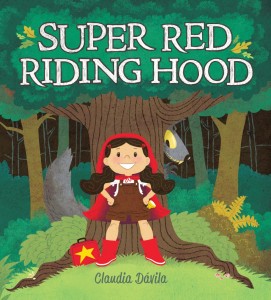 As mother of a child who loves any hero in a cape (particularly if she is female, and sporting Wonder Woman-esque motifs), I knew that Claudia Dávila’s Super Red Riding Hood would be right up our street. Dávila is the former art director for Chirp and Chickadee magazines, a seasoned book designer and illustrator, plus author/illustrator of the The Future According to Luz graphic novels series, but Super Red Riding Hood is her first picture book. It’s about a little girl called Ruby who likes to fancy herself a defender of justice and imagine stories in which she gets to prove her super-hero mettle. While a trip through the woods to collect raspberries isn’t quite the mission she’s been fantasizing about, Ruby makes the most of it, rescuing small creatures and being brave in the face of weird woodland sounds. And so she’s totally ready when she stumbles into a situation requiring actual super-heroics, and has to stare down a ferocious wolf.
As mother of a child who loves any hero in a cape (particularly if she is female, and sporting Wonder Woman-esque motifs), I knew that Claudia Dávila’s Super Red Riding Hood would be right up our street. Dávila is the former art director for Chirp and Chickadee magazines, a seasoned book designer and illustrator, plus author/illustrator of the The Future According to Luz graphic novels series, but Super Red Riding Hood is her first picture book. It’s about a little girl called Ruby who likes to fancy herself a defender of justice and imagine stories in which she gets to prove her super-hero mettle. While a trip through the woods to collect raspberries isn’t quite the mission she’s been fantasizing about, Ruby makes the most of it, rescuing small creatures and being brave in the face of weird woodland sounds. And so she’s totally ready when she stumbles into a situation requiring actual super-heroics, and has to stare down a ferocious wolf.
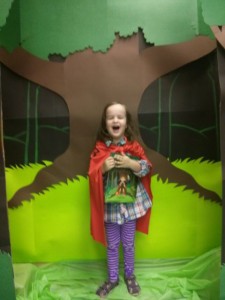 Turns out all that Super-Hero practice has paid off—Ruby stands up for herself, and learns that all her Wolf prejudices aren’t exactly accurate. And the wolf’s impressions of little girls are transformed by his encounter in the woods with Ruby—indeed, little girls can be Super Heroes after all. Which is a lesson that Harriet was already well aware of, but it was awfully nice to have it affirmed.
Turns out all that Super-Hero practice has paid off—Ruby stands up for herself, and learns that all her Wolf prejudices aren’t exactly accurate. And the wolf’s impressions of little girls are transformed by his encounter in the woods with Ruby—indeed, little girls can be Super Heroes after all. Which is a lesson that Harriet was already well aware of, but it was awfully nice to have it affirmed.
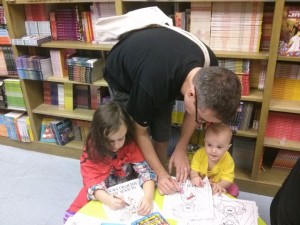 We turned up at Claudia Dávila’s launch yesterday at Little Island Comics, because the store is around the corner from our house, and we were fans of Super Red Riding Hood already. Harriet brought her own red cape, because we assured her that this was a cape-friendly event, though she was apprehensive about its lack of hood.Turned out this was not a problem, and she had fun posing in the big dark woods (with not a big bad wolf in sight, thank goodness).
We turned up at Claudia Dávila’s launch yesterday at Little Island Comics, because the store is around the corner from our house, and we were fans of Super Red Riding Hood already. Harriet brought her own red cape, because we assured her that this was a cape-friendly event, though she was apprehensive about its lack of hood.Turned out this was not a problem, and she had fun posing in the big dark woods (with not a big bad wolf in sight, thank goodness).
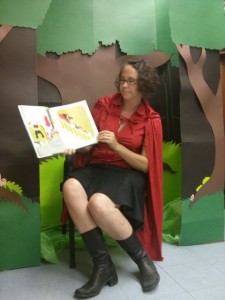 Harriet and Iris enjoyed colouring Super Red Riding Hood, and Harriet made her own Big Bad Wolf puppet, while Iris was chased around the store in circles. Later, we all settled down to listen to Dávila read to us from her book, and she was wonderful, and Harriet had a good time reading along to the parts she knew off by heart already.
Harriet and Iris enjoyed colouring Super Red Riding Hood, and Harriet made her own Big Bad Wolf puppet, while Iris was chased around the store in circles. Later, we all settled down to listen to Dávila read to us from her book, and she was wonderful, and Harriet had a good time reading along to the parts she knew off by heart already.
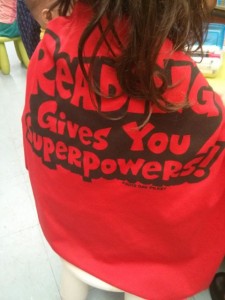 We have two birthday parties to attend this weekend, and both friends will be receiving their own copy of Super Red. Dávila’s fantastic illustrations are matched by a fun and inspiring story that never gets too scary, and reminds boys and girls of all ages that caped crusaders come in all kinds of excellent packages.
We have two birthday parties to attend this weekend, and both friends will be receiving their own copy of Super Red. Dávila’s fantastic illustrations are matched by a fun and inspiring story that never gets too scary, and reminds boys and girls of all ages that caped crusaders come in all kinds of excellent packages.
August 28, 2014
In which we fall in love with Zita the Space Girl
 While it’s true that the summer of 2014 will be remembered (by us) for all sorts of things—the summer we listened to the Frozen soundtrack every time we went in the car; the summer we read Farmer Boy and were bowled over by the force of Almanzo Wilder’s appetite; the summer Harriet watched Annie every day for weeks and weeks; the summer we once ate 36 Creamsicles in six days—it all really comes down to that this is the summer we fell in love with Zita the Spacegirl. Whom we discovered when I was stopping into Bakka Phoenix Books (because we are still spoiled for bookstore choice in this neighbourhood, even after the closing of my beloved Book City) to pick up a copy of Jo Walton’s My Real Children to give to my mom for my birthday (and you already know how much I love this book, right?).
While it’s true that the summer of 2014 will be remembered (by us) for all sorts of things—the summer we listened to the Frozen soundtrack every time we went in the car; the summer we read Farmer Boy and were bowled over by the force of Almanzo Wilder’s appetite; the summer Harriet watched Annie every day for weeks and weeks; the summer we once ate 36 Creamsicles in six days—it all really comes down to that this is the summer we fell in love with Zita the Spacegirl. Whom we discovered when I was stopping into Bakka Phoenix Books (because we are still spoiled for bookstore choice in this neighbourhood, even after the closing of my beloved Book City) to pick up a copy of Jo Walton’s My Real Children to give to my mom for my birthday (and you already know how much I love this book, right?).
 There was a fetching comic book displayed at the cash, and it caught my eye and Harriet’s. “That’s Zita,” we were told. “She’s wonderful.”** And so we came back a few weeks later to buy a copy of the first book in the trilogy. We’re already mad for comic books, and space travel is cool, plus she’s a female superhero—nothing could be more perfect. And the books turned out to be as great as we were promised, with vivid colour illustrations, great writing, delightful and surprising characters, enough robots and aliens to keep things interesting, and the indomitable Zita herself, who is so brave, honourable, fallible, spunky and real. She is a champion of so many things, but first and foremost, a champion of friendship. I love that.
There was a fetching comic book displayed at the cash, and it caught my eye and Harriet’s. “That’s Zita,” we were told. “She’s wonderful.”** And so we came back a few weeks later to buy a copy of the first book in the trilogy. We’re already mad for comic books, and space travel is cool, plus she’s a female superhero—nothing could be more perfect. And the books turned out to be as great as we were promised, with vivid colour illustrations, great writing, delightful and surprising characters, enough robots and aliens to keep things interesting, and the indomitable Zita herself, who is so brave, honourable, fallible, spunky and real. She is a champion of so many things, but first and foremost, a champion of friendship. I love that.
 In the first book, Zita and her friend, Joseph, are playing around and discover a strange device with a bright red button. Being Zita, she presses it, opening a portal to space into which Joseph is taken. After some despairing at what she’s done to her friend, Zita goes in after him, and sets about saving her friend, who’s been captured on this strange planet which is due to be hit with a meteor in due course. She makes unlikely friends, fights foes, and is mistakenly given credit for saving the planet, becoming celebrated as a hero. She manages to get Joseph back to earth, but is not able to get back herself, which she’s not entirely unhappy about, looking forward to adventure as she gets ready to “take the long way home.”
In the first book, Zita and her friend, Joseph, are playing around and discover a strange device with a bright red button. Being Zita, she presses it, opening a portal to space into which Joseph is taken. After some despairing at what she’s done to her friend, Zita goes in after him, and sets about saving her friend, who’s been captured on this strange planet which is due to be hit with a meteor in due course. She makes unlikely friends, fights foes, and is mistakenly given credit for saving the planet, becoming celebrated as a hero. She manages to get Joseph back to earth, but is not able to get back herself, which she’s not entirely unhappy about, looking forward to adventure as she gets ready to “take the long way home.”
The next two books are just as terrific, Zita getting herself out of difficult situations, standing up for justice and the downtrodden, overcoming odds, and staying loyal to her pals. Things settle down nicely by the end of the third book, though it’s just open-ended enough for us to dare to hope that we’ve not seen the last of Zita yet.
Though even if we have, her creator, Ben Hatke, is up to cool things. His latest project is the picture book, Julia’s Home for Lost Creatures, which is out next month. We ordered our copy today.
**And please note that this is the magic of bookstores, such connections happening. No algorithm could have ever ever done that.
July 14, 2014
Comics Comics!
I know that comics lovers are a territorial lot, so I’ll state that I’m in no way impinging upon their authority, but rather documenting my own discovery of passion for the form. I’m a comics newbie (years of Archie-reading aside) but panel by panel, I’m falling in love. We benefit greatly from having Little Island Comics around the corner from our house, but there is also a fine selection of comics available through the library. And as Harriet gets bigger and we don’t read together quite as often as we once did, sharing comics has been a terrific way for us to experience books together.
 Yotsuba: This series was a discovery by my friend, Rebecca Rosenblum, via the five year old in her life. She thought that Harriet and I would enjoy the books too, and she was completely right. These books are a manga series about a little girl called Yotsuba (whose name translates as “Four Leaf Clover), a quirky five year old with a unique way of seeing the world. Yotsuba has a curious if vague background–her adoptive father claims she is an orphan whom he picked up while travelling abroad. The series begins with her and her father settling into a new home in Japan, meeting their neighbours and discovering their new community. Yotsuba is more naive than most five year olds, resulting in amusing misunderstandings, and she is also just like five year olds everywhere in her emotional range and strong passions. She’s funny, gutsy and sweet as she takes part in everyday adventures. Her stories also give North American readers insight into children growing up in a culture different from theirs own.
Yotsuba: This series was a discovery by my friend, Rebecca Rosenblum, via the five year old in her life. She thought that Harriet and I would enjoy the books too, and she was completely right. These books are a manga series about a little girl called Yotsuba (whose name translates as “Four Leaf Clover), a quirky five year old with a unique way of seeing the world. Yotsuba has a curious if vague background–her adoptive father claims she is an orphan whom he picked up while travelling abroad. The series begins with her and her father settling into a new home in Japan, meeting their neighbours and discovering their new community. Yotsuba is more naive than most five year olds, resulting in amusing misunderstandings, and she is also just like five year olds everywhere in her emotional range and strong passions. She’s funny, gutsy and sweet as she takes part in everyday adventures. Her stories also give North American readers insight into children growing up in a culture different from theirs own.
 The Wonderful World of Lisa Simpson: I wrote about this book already after we’d borrowed it from the library, and then we bought our own copy. I think Lisa Simpson is a great character, and this comic is a good introduction to her. In the first story, she imagines herself as ruler of an ancient utopia, but best intentions go awry. In the second story, Lisa signs up Santa’s Little Helper for a dog show, and realizes that neither of them are really the competitive type. And then the final story, in which Lisa opens up her own Little Free Library on the Simpson’s front lawn, but all those books are wasted on the philistines in her midst. I appreciate this collections because each story is written and illustrated by women, which I understand is pretty rare in comics, and also because each artist approaches the images in a slightly different way, giving us new ways to see these characters which have become so familiar. And because it’s a comic about a lending library… the BEST!
The Wonderful World of Lisa Simpson: I wrote about this book already after we’d borrowed it from the library, and then we bought our own copy. I think Lisa Simpson is a great character, and this comic is a good introduction to her. In the first story, she imagines herself as ruler of an ancient utopia, but best intentions go awry. In the second story, Lisa signs up Santa’s Little Helper for a dog show, and realizes that neither of them are really the competitive type. And then the final story, in which Lisa opens up her own Little Free Library on the Simpson’s front lawn, but all those books are wasted on the philistines in her midst. I appreciate this collections because each story is written and illustrated by women, which I understand is pretty rare in comics, and also because each artist approaches the images in a slightly different way, giving us new ways to see these characters which have become so familiar. And because it’s a comic about a lending library… the BEST!
 The Incredibles: Secrets and Lies: I dislike cartoons and children’s movies, but The Incredibles is the exception that that rule. I’ve seen the movie many times and spent every more time discussing its plot lines and gender politics. Plus, it is funny, and I love that Harriet is a fan of Violet–there are worse role models. So we were happy to borrow The Incredibles: Secrets and Lies from the library. It’s a great story in which mother Helen gets a starring role, and then I started channelling Holly Hunter when I read her parts, which might have been irritating to listen to, but was exhilarating to experience. I do appreciate these characters, which so deftly meld my fascination with domestic fiction to Harriet’s with super heroes. There are other books in this series, and I look forward to reading them soon.
The Incredibles: Secrets and Lies: I dislike cartoons and children’s movies, but The Incredibles is the exception that that rule. I’ve seen the movie many times and spent every more time discussing its plot lines and gender politics. Plus, it is funny, and I love that Harriet is a fan of Violet–there are worse role models. So we were happy to borrow The Incredibles: Secrets and Lies from the library. It’s a great story in which mother Helen gets a starring role, and then I started channelling Holly Hunter when I read her parts, which might have been irritating to listen to, but was exhilarating to experience. I do appreciate these characters, which so deftly meld my fascination with domestic fiction to Harriet’s with super heroes. There are other books in this series, and I look forward to reading them soon.
 Wonder Woman: Challenge of the Gods: Wonder Woman was where our family’s comics love began. At Little Island Comics, they sell old comics for a dollar so we started reading Woman Woman issues randomly. Harriet adores them, though I’m not sure how much she understands, and the story lines are so interesting, involving elements of Greek mythology and Wonder Woman’s whole fascinating origin story. These are a bit dangerous though for two reasons: first, that Iris likes to tear the pages, whose flimsiness suits such an activity, and also that some of the story lines are a bit too adult—I kind of had to tiptoe around the Zeus/Wonder Woman rape plot line, but Harriet didn’t notice. It didn’t bother me enough to stop reading them though, mostly because I want to see what happens next. Which I have a feeling was what the series’ writer had precisely intended.
Wonder Woman: Challenge of the Gods: Wonder Woman was where our family’s comics love began. At Little Island Comics, they sell old comics for a dollar so we started reading Woman Woman issues randomly. Harriet adores them, though I’m not sure how much she understands, and the story lines are so interesting, involving elements of Greek mythology and Wonder Woman’s whole fascinating origin story. These are a bit dangerous though for two reasons: first, that Iris likes to tear the pages, whose flimsiness suits such an activity, and also that some of the story lines are a bit too adult—I kind of had to tiptoe around the Zeus/Wonder Woman rape plot line, but Harriet didn’t notice. It didn’t bother me enough to stop reading them though, mostly because I want to see what happens next. Which I have a feeling was what the series’ writer had precisely intended.
July 6, 2014
If I Wrote a Book About You by Stephany Aulenback
 I’ve been an admirer of Stephany Aulenback for at least a decade, since she was Maud Newton‘s Friday blogger and I would read her posts from my closet-sized apartment in Japan, loving the places her links pointed me to, dreaming of my faraway home back in Canada and the possibility that someday I might be a book blogger too. She started her own blog at Crooked House a few years later, which I always enjoyed, in particular her links about babies and motherhood, her thoughtfulness and curiosity about topics most other places on the internet (and elsewhere) reduce to consumerism and polarization. I love that for her, motherhood and literature have always been connected (or maybe it’s just that to read is to be alive, and mothering is something you can do concurrently).
I’ve been an admirer of Stephany Aulenback for at least a decade, since she was Maud Newton‘s Friday blogger and I would read her posts from my closet-sized apartment in Japan, loving the places her links pointed me to, dreaming of my faraway home back in Canada and the possibility that someday I might be a book blogger too. She started her own blog at Crooked House a few years later, which I always enjoyed, in particular her links about babies and motherhood, her thoughtfulness and curiosity about topics most other places on the internet (and elsewhere) reduce to consumerism and polarization. I love that for her, motherhood and literature have always been connected (or maybe it’s just that to read is to be alive, and mothering is something you can do concurrently).
Her second child was born a few weeks after my first, and I have appreciated her frank, funny and creative posts on living with children. Just off the top of my head, the list of wonderful things her blog has pointed me to include Sara O’Leary’s books, Christina Hardyment’s Dream Babies, and my first reading of Harriet the Spy (for which I named my firstborn—seriously, where would I be without Crooked House?). I have also appreciated her writing at places like McSweeneys, in particular, “Words That Would Make Nice Names for Babies, If It Weren’t For Their Unsuitable Meanings”. (I myself have always been partial to Tazer and Latrine.)
So of course, I have been looking forward to the publication of her first book, If I Wrote A Book About You, illustrated by Denise Holmes and published by the splendid Simply Read Books. When I saw an image of the book’s cover a few months ago, I suspected I would not be disappointed, and I wasn’t. Holmes’ illustrations are simply and stylish with a touch of the old-fashioned about them (blushing cheeks), complemented by the stripes and floral prints that offset them.
The book is a love letter from parent to child, a sweet and whimsical expression of affection. “If I wrote a book about you,” the story begins, “and how wonderful you are, I would write it everywhere.” Some of the expressions are more straightforward than others—”I would write that you are perfect in the sand on the beach,” the illustration showing her doing just that. Or “I would write that you are amazing with the telephone wires, and that you are fascinating with the yellow lines that run down the middle of the road,” this page featuring my favourite spread from the book, a homey streetscape (featuring a library!). She ends up writing with noodles, toys on the floor, raindrops on the window, and rays from the sun.
Aulenback’s playfulness with language is evident here, in that with beads on a bracelet, she writes, “charming”, and that her grammar bends in surprising ways that keep the ear attuned–“you are delicious with the noodles in your soup.” I also love the idea that one could write anything with cracker crumbs and toys on the floor, and if this were really the case, I’d be Karl Ove Knausgaard.
For me, the book is testament to the exuberance of love and the creative inspiration that parenthood can bring, though it’s a complicated inspiration. It’s significant, I think, that the book’s title is hypothetical after all. While motherhood might brings with it a whole new brilliant view upon the world, this doesn’t necessary entail sufficient energy or time with which that vision can be captured for all of eternity. (Or maybe it does? Karl Ove apparently has four children, though as yet, he hasn’t written a book about them.)
If I Wrote a Book About You is a book about the curious places in which we writing our stories on the world, about the power of words, a vocabulary lesson, an exercise in imagination, a record of lovely quotidian things, and the ridiculous extent of parental love. You can also take any of the adjectives that appear within the story–charming, beautiful, clever, precious and sweet—and, like magic, they seem to apply to the book that contains them.
July 3, 2014
Best Book of the Library Haul: Spectacles by Ellen Raskin
 Ellen Raskin’s The Westing Game was on my foundational texts, one of the few books from my YA days that I still keep on my shelves. So it was a lovely surprise to discover her books in the picture book section once I started perusing the library with Harriet. Turns out that Raskin was a notable book designer and illustrator, in addition to being a writer. (She designed the first edition jacket for A Wrinkle in Time.) Her picture books are very visual, kind of psychedelic, whimsical and as tricky as The Westing Game. And this week we enjoyed reading Spectacles.
Ellen Raskin’s The Westing Game was on my foundational texts, one of the few books from my YA days that I still keep on my shelves. So it was a lovely surprise to discover her books in the picture book section once I started perusing the library with Harriet. Turns out that Raskin was a notable book designer and illustrator, in addition to being a writer. (She designed the first edition jacket for A Wrinkle in Time.) Her picture books are very visual, kind of psychedelic, whimsical and as tricky as The Westing Game. And this week we enjoyed reading Spectacles.
It is possibly true that we like Spectacles because it features a little girl called Iris. Who didn’t always have glasses, her poor eyesight having previously gotten her into a whole lot of trouble and causing misunderstandings.
For example, what she’d assumed to be a chestnut mare in the parlour (but of course!)…
…turns out to be her babysitter.
These visual tricks constitute most of the book, and does include a racist image of an Native American stereotype. Which is the point at which I point out to Harriet what racism and stereotypes are, and why I’m not comfortable with that page, so all is not lost, and we move on to chestnut mares.
 At the end of the story, it all becomes clear, and Iris has a wide variety of frames to choose from on her visit to the opticians. “Would you like to look younger or older, sweeter or smarter, like a scholar or a movie star?”
At the end of the story, it all becomes clear, and Iris has a wide variety of frames to choose from on her visit to the opticians. “Would you like to look younger or older, sweeter or smarter, like a scholar or a movie star?”
It is unfortunate that Raskin’s picture books are out of print and that most of them are unavailable in our public library system (though they are kept in the archives of the Osborne Collection for Children’s Literature). Definitely books worth keeping an eye out for when cruising garage sales or second-hand bookshops.
*And by the way, I’m excited to welcome back the Best of the Library Haul feature, now that school is out and we once again have time for regular library visits. I’ve missed them. This is going to be fun.
June 26, 2014
Peach Girl by Raymond Nakamura & Rebecca Bender
 I had the pleasure of reviewing Peach Girl by Raymond Nakamura and Rebecca Bender for Quill & Quire. It’s a story about a feisty girl that depicts the gorgeous countryside of Japan, a country that was once my home. I definitely recommend it.
I had the pleasure of reviewing Peach Girl by Raymond Nakamura and Rebecca Bender for Quill & Quire. It’s a story about a feisty girl that depicts the gorgeous countryside of Japan, a country that was once my home. I definitely recommend it.
“In his engaging debut, author Raymond Nakamura puts a feminist bent on the Japanese folk tale Momotaro (Peach Boy).
In Nakamura’s version, a young girl emerges from a giant peach discovered on the doorstep of an elderly couple (who are, notably, a farmer and her husband). Momoko, which translates as “Peach Girl,” is a feisty creature determined to make the world a better place, a mission that involves ridding it of a child-eating ogre. Gently shrugging off her adoptive parents’ concerns for her safety, Momoko embarks on her quest with peach-pit armour for protection, plus a bundle of peach dumplings to eat on the way.”
You can read the whole review here.
June 17, 2014
Hipster Picture Books
 By “Hipster Picture Books”, of course, I mean books with a focus on design over content, I mean the board book as status symbol. The kind of book a child might not necessarily choose on her own, but her parent will buy it for her as sort of an aspirational thing. To aspire to have a child who lusts for a Pantone colour book. And the great thing about these books’ smart design and vibrant colours is the child will like it after all, will eventually be seen at Brunch clutching said book, and then you get to be the kind of parent you always always dreamed of being. Post it on Facebook, and rest on your laurels after that. Undoubtedly, a Sunday well spent.
By “Hipster Picture Books”, of course, I mean books with a focus on design over content, I mean the board book as status symbol. The kind of book a child might not necessarily choose on her own, but her parent will buy it for her as sort of an aspirational thing. To aspire to have a child who lusts for a Pantone colour book. And the great thing about these books’ smart design and vibrant colours is the child will like it after all, will eventually be seen at Brunch clutching said book, and then you get to be the kind of parent you always always dreamed of being. Post it on Facebook, and rest on your laurels after that. Undoubtedly, a Sunday well spent.
I am only half-kidding.
I bought Iris Pantone: Colors for her birthday, and she likes it. It’s visually appealing, and I appreciate its overall message–that there are many shades of grey, and red, and green, and every colour, for that matter. We live in a complicated world, but it’s beautiful. Facing each page of shades is an object in said colour–red wagon, brown teddy bear, blue teapot etc. And then at the end, we’re faced with a rainbow of objects, and this page is an exercise in naming–pickle, monster, kangaroo, bow tie.
 I am also pretty in love with Work: An Occupational ABC by Kellen Hatanaka (out in August). The minimalist illustrations still reveal vital details and are smart and dynamic. I love the way that each letter of the alphabet is embedded into the illustrations in clever ways (i.e. I is for “Ice Cream Vendor” the ice cream is being vended from the I itself’; the A in “Aviator” is part of the mountain range; the P for “Postal Worker” is a cumbrous package on the postie’s back). Points for some very cool jobs I wouldn’t have considered: O is for Oceanographer, N is for Naval Architect (none of them thriving industries, I am sure, but still…). And then an amusing glossary of terms at the end: “Zookeeping might be the only job that encourages monkey business.” Fun.
I am also pretty in love with Work: An Occupational ABC by Kellen Hatanaka (out in August). The minimalist illustrations still reveal vital details and are smart and dynamic. I love the way that each letter of the alphabet is embedded into the illustrations in clever ways (i.e. I is for “Ice Cream Vendor” the ice cream is being vended from the I itself’; the A in “Aviator” is part of the mountain range; the P for “Postal Worker” is a cumbrous package on the postie’s back). Points for some very cool jobs I wouldn’t have considered: O is for Oceanographer, N is for Naval Architect (none of them thriving industries, I am sure, but still…). And then an amusing glossary of terms at the end: “Zookeeping might be the only job that encourages monkey business.” Fun.
 The exuberance of 100 Hungry Monkeys doesn’t really qualify it as a hipster picture book (hipsters are not allowed to get excited, except about drinking Pabst Blue Ribbon on a park bench, or riding a unicycle, but in either case, would never show it). But its visual appeal puts this book in the mix, and it is definitely a good one. Author-illustrator Masayuki Sebe has created a fun story about the concept of the number 100, one whose prompts urge readers to examine the illustration for details and clues in a Where’s Waldo fashion. This is another run one for early readers and their parents to read together, reminding both that books and reading are fun.
The exuberance of 100 Hungry Monkeys doesn’t really qualify it as a hipster picture book (hipsters are not allowed to get excited, except about drinking Pabst Blue Ribbon on a park bench, or riding a unicycle, but in either case, would never show it). But its visual appeal puts this book in the mix, and it is definitely a good one. Author-illustrator Masayuki Sebe has created a fun story about the concept of the number 100, one whose prompts urge readers to examine the illustration for details and clues in a Where’s Waldo fashion. This is another run one for early readers and their parents to read together, reminding both that books and reading are fun.
 And finally, Monsters Under Bridges by Rachel Roellke Coddington and Jolby is not really a hipster picture book, but it is geographically situated in the Pacific Northwest, so there you go. It is a concept I wasn’t entirely sure about at first–a travel guide featuring notable bridges and describing the fabled creatures who live under them, their lives and habits. Perhaps its a regional thing, I wondered? But then Harriet, who has never once been to Seattle, loved this book, and had me reading it to her over and over again, her mind expanded by the crazy creatures imagined within. And through her (which happens often), I discovered just what this book was all about. BONUS CANCON: Ronoh who lives under the Ironworkers Memorial Bridge in Vancouver BC, who smells like seaweed and wisdom. Plus Margot the Maripolo, beneath the Capilano Suspension Bridge and Sherman who lives under North Arm Bridge in Richmond BC (who likes to strap himself to the front of the SkyTrain).
And finally, Monsters Under Bridges by Rachel Roellke Coddington and Jolby is not really a hipster picture book, but it is geographically situated in the Pacific Northwest, so there you go. It is a concept I wasn’t entirely sure about at first–a travel guide featuring notable bridges and describing the fabled creatures who live under them, their lives and habits. Perhaps its a regional thing, I wondered? But then Harriet, who has never once been to Seattle, loved this book, and had me reading it to her over and over again, her mind expanded by the crazy creatures imagined within. And through her (which happens often), I discovered just what this book was all about. BONUS CANCON: Ronoh who lives under the Ironworkers Memorial Bridge in Vancouver BC, who smells like seaweed and wisdom. Plus Margot the Maripolo, beneath the Capilano Suspension Bridge and Sherman who lives under North Arm Bridge in Richmond BC (who likes to strap himself to the front of the SkyTrain).
